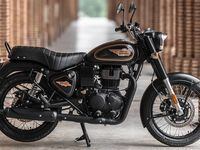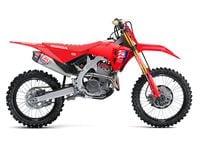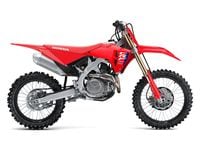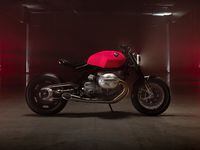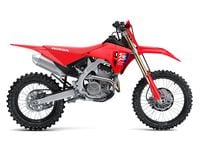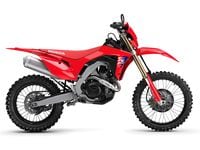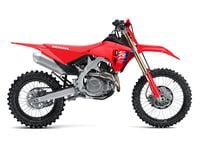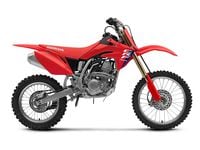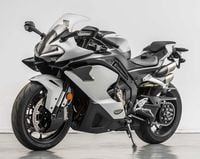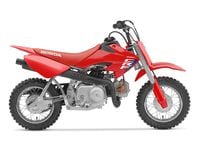Well here’s something you don’t see every day—a late adopter like yours truly actually coughing up $12K (plus tax, licensing, etc.) of his own money for a motorcycle we’ve not yet tested here in the magazine.
Yes, last month I went out on a limb and bought a new 2016 Triumph Bonneville T120—right out of the crate—and took it in just yesterday for its 500-mile break-in service. Which was actually a 640-mile break-in service because I couldn't stay off it for a full weekend.
Truth be told, this was not completely a blind impulse purchase. I’d previously visited our local Triumph dealership, Team Triumph in Janesville, Wisconsin, to take a look at the first of these new liquid-cooled 1,200cc Bonnevilles when it came in. It was Cranberry Red and Aluminum Silver.
I sat on the bike and was relieved to find a little more legroom than I had on my old 2008 Bonneville, as the seat was about an inch and a half higher relative to the pegs. Nice bars too. A little flatter and lower.
Also, the overall level of finish had taken a pleasing jump in quality (as it well should have, for the approximate $3K price hike), and it came stock with a centerstand, passenger grab rail, heated grips, ABS, and stock mufflers that actually sounded rich and euphonious, rather than stolen off a Lawn-Boy. Also, the engineers had taken the dreaded kink out of the exhaust system. It seemed complete, in need of no costly options.
So first impressions were good, but of course I would have to politely ask for a test ride before making any expensive decisions.
At that moment a sales associate named Kristi Hall came out of the office and hung a “Sold” tag on the handlebars.
“A man who looked at this bike yesterday just called and said he’d take it,” she explained.
So much for my theoretical test ride.
“Are you getting another one in this color?” I asked. The other options were solid red or black tank with contrasting shiny bits, or the “none more black” version for that matte Gothic look, but I was sold on the traditional red-scallop-on-silver paint scheme, reminiscent of the 1969 and ’70 Bonnevilles.
“I don’t think so,” she said. “Maybe in the fall, when the 2017s come out.”
Bummer. My shoulders slumped and I tried to radiate an aura of abject defeat and depression.
It apparently worked because two days later Todd and Darcy Ligman, the owners of the shop, called to say they might be able to get a red and silver bike out of a dealership in northern Illinois, if they made a rather complex three-way trade involving a red and black bike and maybe some Manchurian Railroad bonds. Was I still interested?
Oh, boy, the pressure was on.
“Yes,” I said, after giving it five or six seconds of deep thought.
Luckily, by the time the Bonneville arrived a few days later, they’d also gotten in a black T120 demo bike, so I was able to give that a pretty long test ride on some of my favorite roads along the Rock River before finalizing the deal. I returned suitably impressed and said, “Where do I sign?” Or words to that effect.
And 640 miles later?
It’s as if someone at Triumph had asked owners for a list of all the things that could be improved on the last-generation Bonneville (of which I’ve owned two) and then acted on it. First, the engine.
It's gone from 865 to 1,200cc, and a 1,200 is a big, beefy engine for a bike this size—old-time Harley FLH big—but now with liquid-cooling, fuel injection, overhead cams, and four valves per cylinder. The magazine's test T120 put out 72 bhp at 6,330 rpm and 72 pound-feet of torque at a mere 3,280 rpm, a torque increase of 54 percent from the last generation. What these numbers don't really get across is the smooth, effortless, do-everything hustle of this engine. In town, it's docile and sweet running as a low-compression Triumph Twin of the '50s, but when you roll on the throttle it moves out with a muscular, locomotive force and a deep, throaty purr from the exhaust. Kind of like a cat the size of your house. It's not a two-stage engine that suddenly comes up on cam but a refined, willing powerhouse that simply does whatever you ask it to do, without any fuss.
Traditionalists have complained that it no longer has a 360-degree crank, like its many predecessors, and that the 270-degree crank lacks that snotty, ripping sound of yore and makes it sound too much like a V-twin. It does have a more laid-back shuffle than previous Bonnies, but—mated to the new six-speed transmission with taller gearing—the sound is a lot less busy and tiring on the road. Personally, I like it.
On my last Bonneville, I was always looking for a sixth gear that wasn’t there; with this one I often find myself cruising serenely in fourth or fifth on the highway only to realize (properly embarrassed) that I’ve got a gear or two left. At 70 mph, it’s turning an effortless 3,100 rpm, with almost 4,000 left on the tach before redline. The engine doesn’t mind revving, but after about 5,500 rpm there’s not much need. It’s a smooth torque-monster on the highway, and around town it shrugs off lugging and lazy shifting.
Speaking of which, the new six-speed may be the slickest and most precise-shifting gearbox I’ve experienced on a bike. This and a nicely weighted, progressive clutch and powerful but linear dual front brakes make this bike pleasantly easy to ride on a winding back road, as if you’re using just your fingertips to control the bike. This sense is enhanced by the neutral/friendly handling characteristics.
I went on a ride last week with my friend Mike Collins, who now owns my 2008 red-and-silver Bonneville, and we both agreed after back-to-back rides that the old bike has a slight gyroscopic resistance to turn-in, while the T120 simply heels over and goes exactly where you think it should. Mike, incidentally, said he will probably buy a new Bonneville this fall. The old bike is still fun, charming, good-looking, and (I think) has more of a traditional, direct mechanical feel, so making that trade is not necessarily a slam-dunk option, but both of us were won over by the power and solid, unified feel of the roomier—but slightly heavier—new version.
Also improved is the suspension, which I would rate as being in the firm-but-compliant school. The T120 doesn’t get the fully adjustable Showa fork of the café-racier Thruxton R, or that bike’s Öhlins rear shocks, but it’s still a step up from the last generation in damping and road feel through the fork.
So the basic functional architecture is there for a bike that handles, stops, and goes. My main complaint with the last Bonneville was that cramped seating position for my long legs, and I thought a modern 865cc bike should have more power—or at least be as quick as, say, a Ducati 620 Monster. Also, I didn’t like that bent exhaust system. If Triumph had fixed just those three things, I would have been happy to buy another one. Well, the Hinckley company did, but it has also gone far beyond those improvements. Let us count the ways.
There are stock heated grips, for instance, with a neat two-position switch on the left handgrip. These are a big deal when you live only a few hours from Lambeau Field, home of the frozen tundra. Not to mention cheerleaders. Also on the left bar is an Information button that cycles effortlessly through overall mileage, present fuel mileage, overall fuel mileage, two trip odometers, and a digital clock. It’s so simple even I can use it, intuitively. The almost invisible ABS takes the stress out of sudden stops at sandy or gravel-strewn intersections.
Then there’s liquid-cooling. I winced a bit when I first heard this, but the engineers did a nice job of blending in the flat-black radiator—which is only a little bigger than the old oil cooler—and there’s much to be gained, such as mileage. Triumph claims mpg is up 36 percent in this generation, and my T120 cruising Wisconsin back roads has delivered about 55 mpg versus the typical 45 on my old (admittedly carbureted) T100. The nutters testing at CW HQ turned in a 47-mpg best, which suggests they should relax and enjoy the scenery a bit more. Nonetheless, with its 3.8-gallon tank, the T120’s range comfortably approaches 175 miles before fear and foreboding set in.
I suppose liquid-cooling will make the bike more complicated to restore 30 years from now, but my doctor has promised me I won’t live that long. In the meantime, I like that radiator.
For those hooked on big, rangy adventure-tourers or pure, high-horsepower sportbikes, this is obviously not one of those. It’s basically a standard motorcycle that brings a lot of fun back into riding by being both versatile and easy to live with—and easy to park and move around the garage, sort of like a sophisticated Honda CB350 on steroids. But it’s also a standard that has upped the game in performance, finish, and refinement, taking the concept to the next level of modernity, where all the components cooperate with the will of the rider. It’s a complete motorcycle, with no lingering list of should-have-dones.
Oddly, the more modern the Bonneville becomes, the more it generally resembles those ’60s versions I admire. It has fuel-injection throttle bodies that look like old Amal Monoblocks (sans cables), the best-looking exhaust system in years—with a catalytic converter hidden under the engine—and a nicely finned head and cylinders with a camouflaged radiator in front of them. Yet it looks clean and simple and works better than any British twin I’ve owned.
As an heir to the original 1959 Bonneville, has it become too refined and painless to use, without enough hair-shirt edginess?
Not for me. I love the new Bonneville T120. But then I generally have an old British bike in the garage to restore and work on when I need to bask in the elegant simplicity (and occasional heartbreak) of the past.
In the meantime, I like to ride as much as possible while the sun is still shining. Preferably on a bike I enjoy looking at when it’s parked.
BRADLEY ADAMS, Associate Editor
I would have fallen in love with the Triumph T120 had I not already given my heart to the Thruxton R earlier this year. The T120 looks great, runs strong, and, like the rest of Triumph's lineup, it perfectly integrates modern technologies into a classically styled package. Still, having ridden sportbikes my whole life, I don't mind the Thruxton's more aggressive riding position, and I actually appreciate the bike's more committed demeanor.
DON CANET, Road Test Editor
Triumph has faithfully re-created the retro experience and has done so without sacrificing a bit of modern refinement. The fork gaiters, tank badges, kneepads, flat saddle, rear grab handle, and sweet note from dual peashooter-style mufflers all sing the hip lyrics of the 1960s. What's more, this ride-by-wire parallel twin is tuned for a mountain of smooth torque delivery with a ride quality to match. It truly is the epitome of "Magic Carpet Ride." Let the sound take you away.
MARK HOYER, Editor-in-Chief
I stop and sigh when I walk past the front window of my house and see the T120 parked in the yard, the sweet light of the waning day caressing the bike's beautiful lines. It seems to induce some kind of moto-endorphin that soothes the stressed-out soul. It's even better from the saddle, with so much easy torque and fine fueling from those "carburetors." Despite its retro style, this is one of the sweetest all-around standards on the market.
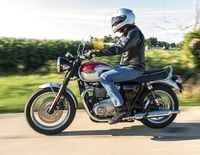
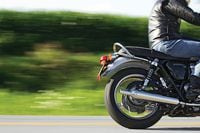
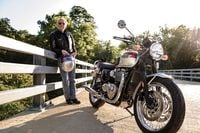
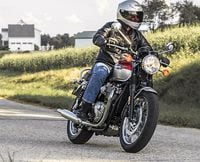
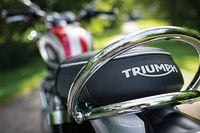

/cloudfront-us-east-1.images.arcpublishing.com/octane/RFA27P66MREOFORFXK4JYQTPPE.jpg)
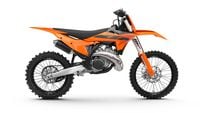
/cloudfront-us-east-1.images.arcpublishing.com/octane/N575KB7BDZDPPJBRLZRG2ANHKI.jpg)
/cloudfront-us-east-1.images.arcpublishing.com/octane/T77HXRXV4NGKDNZODMSEIBRXPE.jpg)
/cloudfront-us-east-1.images.arcpublishing.com/octane/NKMM7V2P3BCSXAV6J56FKK67OU.jpg)
/cloudfront-us-east-1.images.arcpublishing.com/octane/SWQRQV27DNFA7LXGFI7FNFNGOQ.jpg)
/cloudfront-us-east-1.images.arcpublishing.com/octane/GYEXUJBV5JGQLLZNXO7KRVSTEY.jpg)
/cloudfront-us-east-1.images.arcpublishing.com/octane/MCWUSJJVJVG45P7QQG3WOXZR54.jpg)
/cloudfront-us-east-1.images.arcpublishing.com/octane/AJ4EFPH2CRDURDAB5LPEA2V2NE.jpg)
/cloudfront-us-east-1.images.arcpublishing.com/octane/LSDHIL22SZAFFPYLKP5ZXLJSIY.jpg)
/cloudfront-us-east-1.images.arcpublishing.com/octane/SH46HIOX4RELXLXF6AE3SFGH4A.jpg)
/cloudfront-us-east-1.images.arcpublishing.com/octane/JUZ52WFWLJGMNH7PGZNOKP3MUY.jpg)
